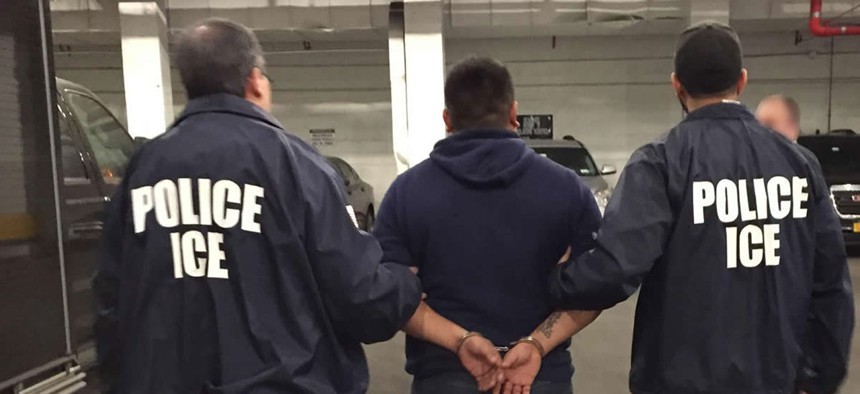
Immigrations and Customs Enforcement file photo
How Trump Is Changing Immigration Enforcement
The president’s directive on immigration might resemble the record deportations of Obama’s first term—but without the corresponding push for legalization.
In his first week in office, President Donald Trump acted on his core campaign issue: immigration. In a short span of time, the president signed executive orders calling for the construction of a wall on the U.S.-Mexico border and a crackdown on so-called “sanctuary cities,” which limit collaboration between local authorities and federal immigration agents.
The orders fell in line with Trump’s repeated pledge to control illegal immigration in the United States and suggested that Trump will likely pursue an immigration agenda that resembles the aggressive deportations of former President Obama’s first term. The Obama administration deported record numbers of undocumented immigrants, much to the frustration of immigrant advocates. In his first term alone, he deported 1.5 million undocumented immigrants. By the end of his tenure, Obama had deported more people than his most recent predecessors, Bill Clinton and George W. Bush, though the number of deportations dipped after his second term. There was also a corresponding push for legalization under the Obama administration—and that push is absent from Trump’s order.
Obama’s successor has already put forth new, more stringent criteria for deportation. With the establishment of a new deportation program in 2014, the Obama administration sought to prioritize deporting undocumented immigrants who broke the law over those who did not. That year, the Department of Homeland Security created the Priority Enforcement Program, which focused on undocumented immigrants who posed a threat to “national security, border security, and public safety.”
“The intent of this new policy is to provide clearer and more effective guidance in the pursuit of those priorities,” wrote then-Department of Homeland Secretary Jeh Johnson in a 2014 memo.
The Obama administration’s new approach meant scrapping the Secure Communities Program, in which local law enforcement shared digital fingerprints of people booked into jail with federal authorities, who would then determine whether an individual was in the country illegally and whether to pursue deportation. The program originated in the George W. Bush administration and had received backlash from city officials, who said it was driving a wedge between law enforcement and the communities they police. “Its very name has become a symbol for general hostility toward the enforcement of our immigration laws,” Johnson wrote in a 2014 memo.
The executive order signed by Trump last week, dubbed “Enhancing Public Safety in the Interior of the United States,” adopted a priority system that is far broader than the previous administration’s after 2014. Trump’s order specifically names “aliens who have been convicted of any criminal offense; have been charged with any criminal offense, where such charge has not been resolved; have committed acts that constitute a chargeable criminal offense; have engaged in fraud or willful misrepresentation in connection with any official matter or application before a governmental agency; have abused any program related to receipt of public benefits; are subject to a final order of removal, but who have not complied with their legal obligation to depart the United States; or in the judgment of an immigration officer, otherwise pose a risk to public safety or national security.”
The language used in the order suggests that an individual does not need to be convicted of a crime to be considered for removal. That goes further than the Obama administration’s 2014 directive, which explicitly noted that to be considered a priority for deportation, an undocumented immigrant must be convicted of an offense. “The enforcement priorities are much more loose,” said Kevin Appleby, the senior director of international migration policy at the Center for Migration Studies, a think tank focused on immigration. “[Trump] is casting a wider net.”
The Trump administration also intends to reinstate the Secure Communities Program, despite the friction it caused between local authorities and the communities they protect.
Clarissa Martínez De Castro, the deputy vice president of the Office of Research, Advocacy, and Legislation at National Council of La Raza, said Trump’s revival of the program—and the broad language used in listing priorities—indicates that he has a different perspective from that of his predecessor. “When the executive orders that you are putting on the table are predicated aggressively on misinformation or outright lies about the immigrant community, I think there’s a huge gap,” she said.
“Obama’s stated goal was to reform the system, bring people out of the shadows, put them on a path to citizenship, so it didn’t make sense to advocates that he was pursuing Secure Communities,” as well as another federal program that involved local authorities, Appleby said.
Also included in the executive order are measures to penalize “sanctuary cities,” or jurisdictions that adopt policies to shield undocumented immigrants from deportation. During his presidential campaign, Trump vowed to block federal funds to such jurisdictions, a measure he included in the order. Sanctuary cities, the text reads, “are not eligible to receive Federal grants, except as deemed necessary for law enforcement purposes by the Attorney General or the Secretary.”
It’s not clear what federal grants that includes, but withholding them may take the administration into precarious legal territory. As Lena Graber, a special projects attorney at the Immigrant Legal Resource Center, told me earlier this month, Supreme Court precedent, like the 2012 ruling that upheld Obamacare, might present an obstacle. That ruling found that the Affordable Care Act’s withdrawal of Medicaid funds for states that did not agree to expand Medicaid was unconstitutionally coercive.
But the text of the order itself also presents its own limitations. Rick Su, a law professor at the University at Buffalo who studies immigration and local government, noted that the Trump administration used Section 1373 to define what constitutes a sanctuary city. That section says that any government entity or official who decides to voluntarily collaborate with federal immigration agents cannot be prohibited from doing so. It does not, however, require communication between local and state governments and federal immigration agents.
The Obama administration also put pressure—though arguably at a lesser degree—on sanctuary cities to cooperate with deportation requests, a move that garnered support from conservatives. Last year, the administration announced a policy that would require authorities to turn over undocumented immigrants who have finished their sentences in federal prison and are eligible for deportation.
Still, the federal government is largely dependent on local authorities to identify individuals who may be in the country illegally and turn them over to federal immigration agents.
Trump appears to have noted that limitation in his executive order. “[There was] a lot of bluster and talk about penalizing sanctuary cities, but for all the extreme positions, the order recognized that the president’s power is arguably quite limited,” Su said. This might also be true for the creation of the Office for Victims of Crimes Committed by Removable Aliens, which would issue reports “studying the effects of the victimization by criminal aliens” in the country. Presumably, that office would also rely on data from local authorities. Congress might, too, present a hurdle, as they would need to approve funding to implement these proposals.
Still, anti-immigrant groups appear to be pleased with the administration’s orders. “The president’s decision to strip federal funds from dangerous sanctuary cities is also a welcomed move,” Dan Stein, president of the Federation for American Immigration Reform, said in a statement released in response to the executive orders. “While this action will not bring back the thousands of innocent lives lost or destroyed by reckless sanctuary policies, it will go a long way to making sure this senseless and preventable carnage doesn’t continue.”
While Obama’s and Trump’s immigration-enforcement policies are not identical, neither one is free from challenges, whether that be funding issues or pushback from communities and advocacy groups. “In the end,” Appleby said. “We’ll have to look at the numbers and see where both presidents were after their first term.”
NEXT STORY: The Underrated Art of Persuasion







